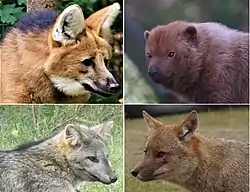Cerdocyonina
Cerdocyonina is an extant subtribe of the canines and is exclusively endemic to the Americas. Often described to be "fox-like" in appearance and behavior, they are more closely related to the wolf-like canids such as Canis than they are to the fox genus Vulpes.[1] Its members are colloquially known as the South American canids.[2] They are sometimes referred to as South American foxes in the older literature, but the term zorro has been recommended by mammalogists to avoid confusion with the true foxes of the tribe Vulpini (i.e., Vulpes)
| Cerdocyoninans | |
|---|---|
 | |
| Four representatives of cerdocyonine canids. Clockwise, starting from top left, are the maned wolf (Chrysocyon brachyurus), the bush dog (Speothos venaticus) the crab-eating fox (Cerdocyon thous) and the Andean fox (Lycalopex culpaeus) | |
| Scientific classification | |
| Kingdom: | Animalia |
| Phylum: | Chordata |
| Class: | Mammalia |
| Order: | Carnivora |
| Family: | Canidae |
| Subfamily: | Caninae |
| Tribe: | Canini |
| Subtribe: | Cerdocyonina Tedford et al., 2009[1] |
| Genera[1] | |
Taxonomy
Cerdocyonina is a natural lineage whose common ancestor was sister to the Eucyon–Canis–Lycaon lineage. It is represented in the fossil record by Cerdocyon 6–5 million years ago, and by Theriodictis and Chrysocyon 5–4 million years ago. It most likely emerged from Central America.[3]:150
The fossil of a large form of the extinct Theriodictis that dates 2 million years ago was found in Florida. The maned wolf and an extinct species of the crab-eating zorro were in North America around this time, which was before the Isthmus of Panama came into being, indicating the origin of the Cerdocyonina in North America.[2]:53
Prior to the 1990s there have been different systematic hypotheses pertaining to the relationships among South American canids, most frequent was the notion of there being three genera and subgenera (after Langguth 1969[4] and 1970[5]):
- Genus Cerdocyon
- Subgenus Atelocynus
- Subgenus Cerdocyon
- Subgenus Speothos
- Genus Dusicyon
- Subgenus Lycalopex (Langguth recognized it as "Pseudalopex")
- Subgenus †Dusicyon
- Genus Chrysocyon
Morphological and DNA evidence shows that the South American canids, being the most diverse group of canids on any continent, forms its own natural group.[2]
These taxa, representing diverse adaptations, can be diagnosed by the following synapomorphies: angular process of the mandible wide, may lack hooklike termination, expansion accommodates widened insertions for pterygoid muscle segments, especially that for the medial branch of the internal pterygoid; posterior cusp of p3 weak or absent; and m1 hypoconid and entoconid, joined by cristids. The Cerdocyonina lacks the strongly arched zygoma and often the second posterior cusp on p4 between the cingulum and the large first cusp, which marks them as primitive relative to Eucyon and its sister taxon the subtribe Canina, which shares these synapomorphies.
In 2018, a study found that the extinct South American Canis gezi did not fall under genus Canis and should be classified under the Cerdocyonina, however no genus was proposed.[6]
The cladogram below is based on the phylogeny of Lindblad-Toh et al. (2005),[7] modified to incorporate recent findings on Lycalopex species[8] and Dusicyon.[9]
| Cerdocyonina |
| |||||||||||||||||||||||||||||||||||||||||||||||||||||||||||||||
References
- Tedford, Richard H.; Wang, Xiaoming; Taylor, Beryl E. (2009). "Phylogenetic Systematics of the North American Fossil Caninae (Carnivora: Canidae)" (PDF). Bulletin of the American Museum of Natural History. 325: 1–218. doi:10.1206/574.1. hdl:2246/5999.
- Wang, X.; Tedford, R.H. (2007). "Ch1-Evolutionary History of Canids". In Jensen, Per (ed.). The Behavioural Biology of Dogs (1 ed.). Cabi Publishing. p. 11. ISBN 978-1845931872.
- Wang, Xiaoming; Tedford, Richard H. (2008). Dogs: Their Fossil Relatives and Evolutionary History. Columbia University Press, New York. pp. 1–232. ISBN 978-0-231-13529-0.
- Lannguth, A. (1969). Die südamerikanischen Canidae unter besonderer Berücksichtigung des Mähnenwolfes Chrysocyon brachyurus Illiger: (Morphologische, systematische und phylogenetische Untersuchungen). Geest und Portig.
- Lannguth, A. (1970). "Una nueva clasificación de los cánidos sudamericanos". Actas del IV Congreso Latinoamericano de Zoología. 1: 129–143.
- Zrzavý, Jan; Duda, Pavel; Robovský, Jan; Okřinová, Isabela; Pavelková Řičánková, Věra (2018). "Phylogeny of the Caninae (Carnivora): Combining morphology, behaviour, genes and fossils". Zoologica Scripta. 47 (4): 373–389. doi:10.1111/zsc.12293. S2CID 90592618.
- Lindblad-Toh, Kerstin; Wade, Claire M.; Mikkelsen, Tarjei S.; Karlsson, Elinor K.; Jaffe, David B.; Kamal, Michael; et al. (2005). "Genome sequence, comparative analysis and haplotype structure of the domestic dog". Nature. 438 (7069): 803–819. Bibcode:2005Natur.438..803L. doi:10.1038/nature04338. PMID 16341006.
- Tchaicka, Ligia; de Freitas, Thales Renato Ochotorena; Bager, Alex; Vidal, Stela Luengos; Lucherini, Mauro; Iriarte, Agustín; et al. (2016). "Molecular assessment of the phylogeny and biogeography of a recently diversified endemic group of South American canids (Mammalia: Carnivora: Canidae)" (PDF). Genetics and Molecular Biology. 39 (3): 442–451. doi:10.1590/1678-4685-GMB-2015-0189. PMC 5004827. PMID 27560989.
- Slater, G. J.; Thalmann, O.; Leonard, J. A.; Schweizer, R. M.; Koepfli, K.-P.; Pollinger, J. P.; et al. (2009). "Evolutionary history of the Falklands wolf". Current Biology. 19 (20): R937–R938. doi:10.1016/j.cub.2009.09.018. hdl:10261/58562. ISSN 0960-9822. PMID 19889366.
